Research Project: Talent Management as a Key HRM Component
VerifiedAdded on 2022/12/29
|30
|6554
|46
Report
AI Summary
This report, a research project on talent management, explores its significance as a key component of Human Resource Management (HRM). The study investigates the impact of talent management on organizational development, employee performance, and retention, with a case study focusing on Marks & Spencer. It examines the benefits of effective talent management practices, such as improved hiring techniques, employee development, and enhanced organizational culture. Furthermore, the report identifies challenges associated with poor talent management, including issues such as talent market tightness, leadership gaps, and high turnover rates. The research utilizes both primary and secondary data analysis to provide insights into talent management strategies, roles, and their influence on the overall success of an organization. The report also includes recommendations based on the findings. The report delves into the critical role of talent management in attracting, developing, and retaining employees, ultimately contributing to the success of any organization.
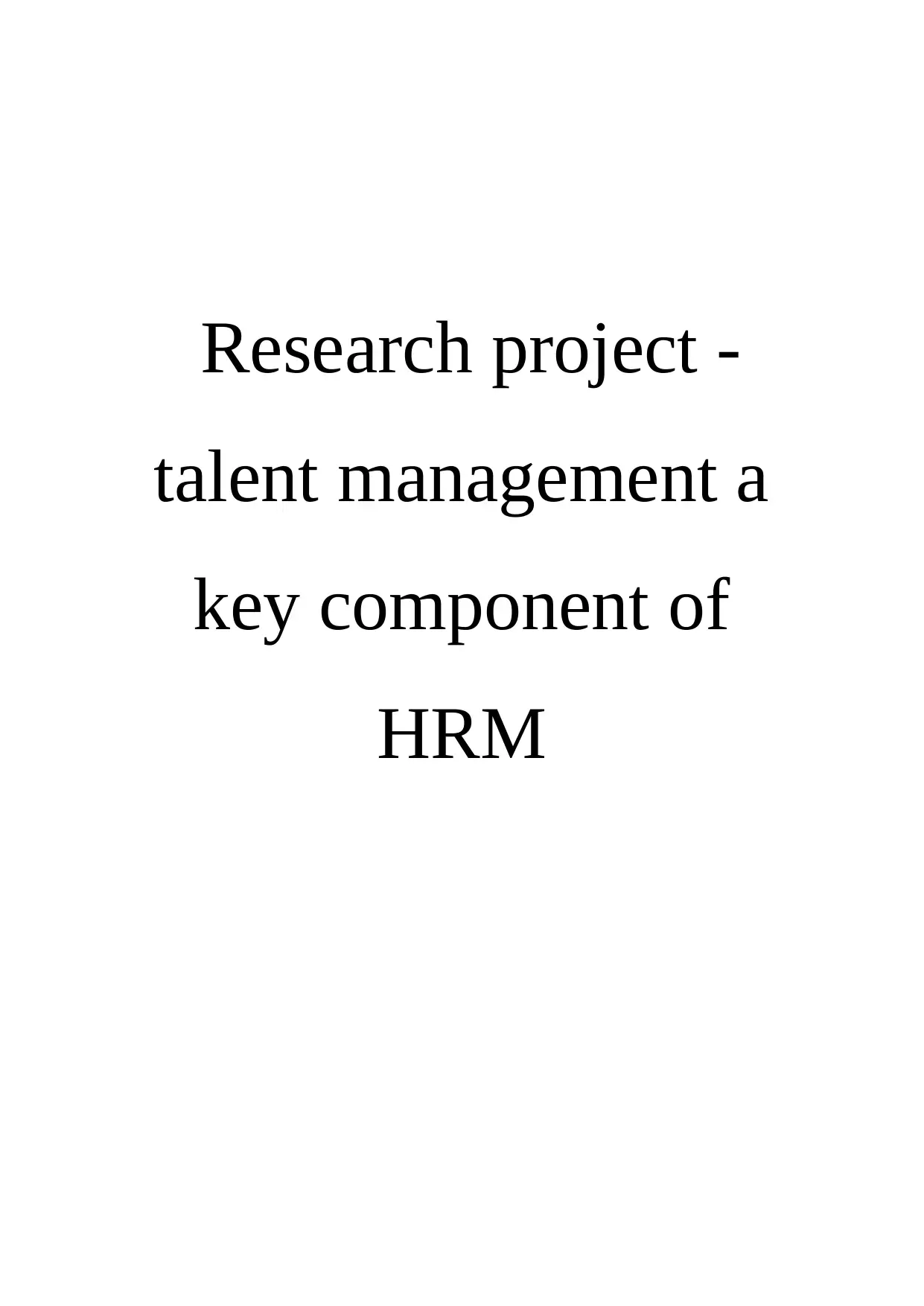
Research project -
talent management a
key component of
HRM
talent management a
key component of
HRM
Paraphrase This Document
Need a fresh take? Get an instant paraphrase of this document with our AI Paraphraser
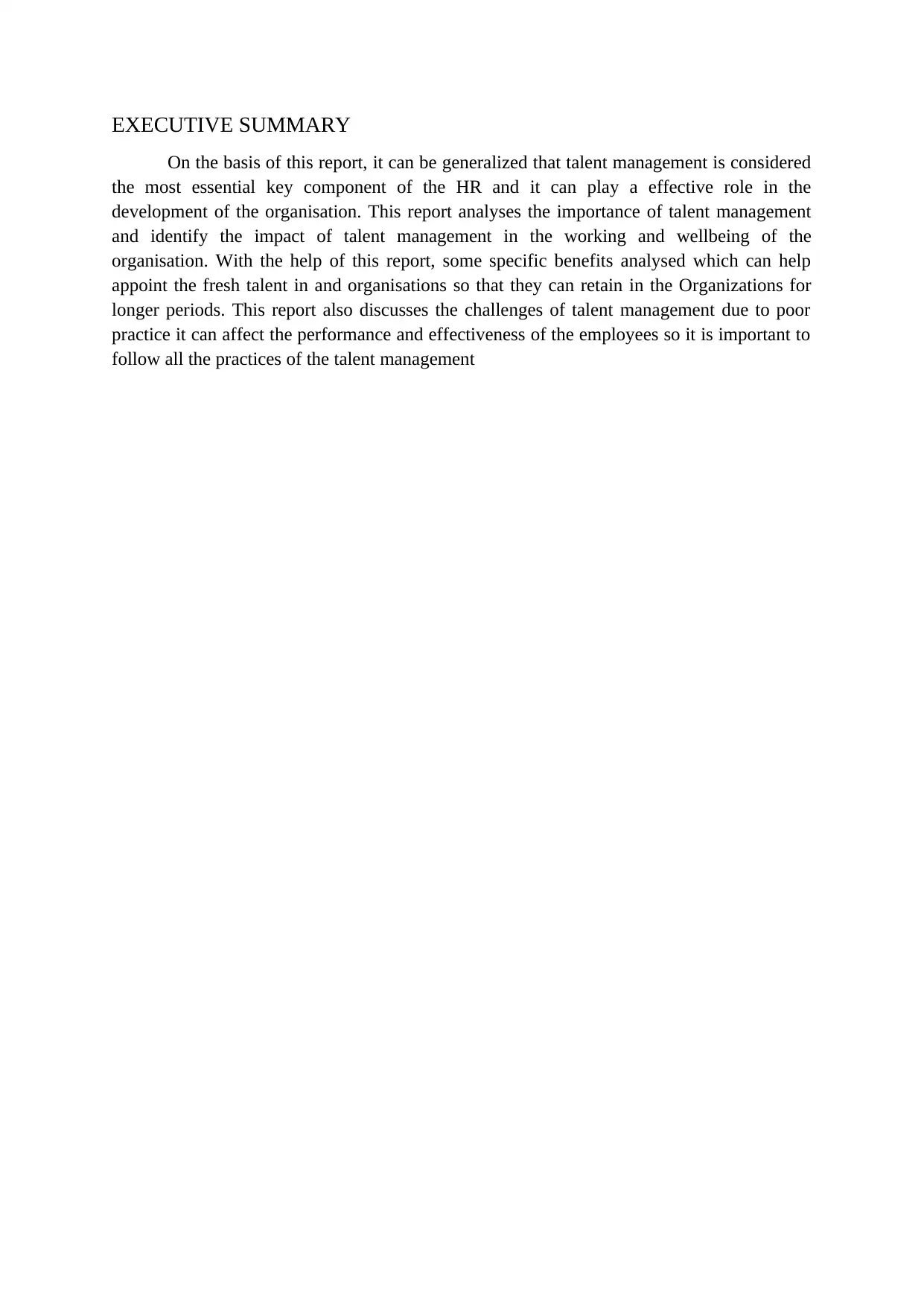
EXECUTIVE SUMMARY
On the basis of this report, it can be generalized that talent management is considered
the most essential key component of the HR and it can play a effective role in the
development of the organisation. This report analyses the importance of talent management
and identify the impact of talent management in the working and wellbeing of the
organisation. With the help of this report, some specific benefits analysed which can help
appoint the fresh talent in and organisations so that they can retain in the Organizations for
longer periods. This report also discusses the challenges of talent management due to poor
practice it can affect the performance and effectiveness of the employees so it is important to
follow all the practices of the talent management
On the basis of this report, it can be generalized that talent management is considered
the most essential key component of the HR and it can play a effective role in the
development of the organisation. This report analyses the importance of talent management
and identify the impact of talent management in the working and wellbeing of the
organisation. With the help of this report, some specific benefits analysed which can help
appoint the fresh talent in and organisations so that they can retain in the Organizations for
longer periods. This report also discusses the challenges of talent management due to poor
practice it can affect the performance and effectiveness of the employees so it is important to
follow all the practices of the talent management
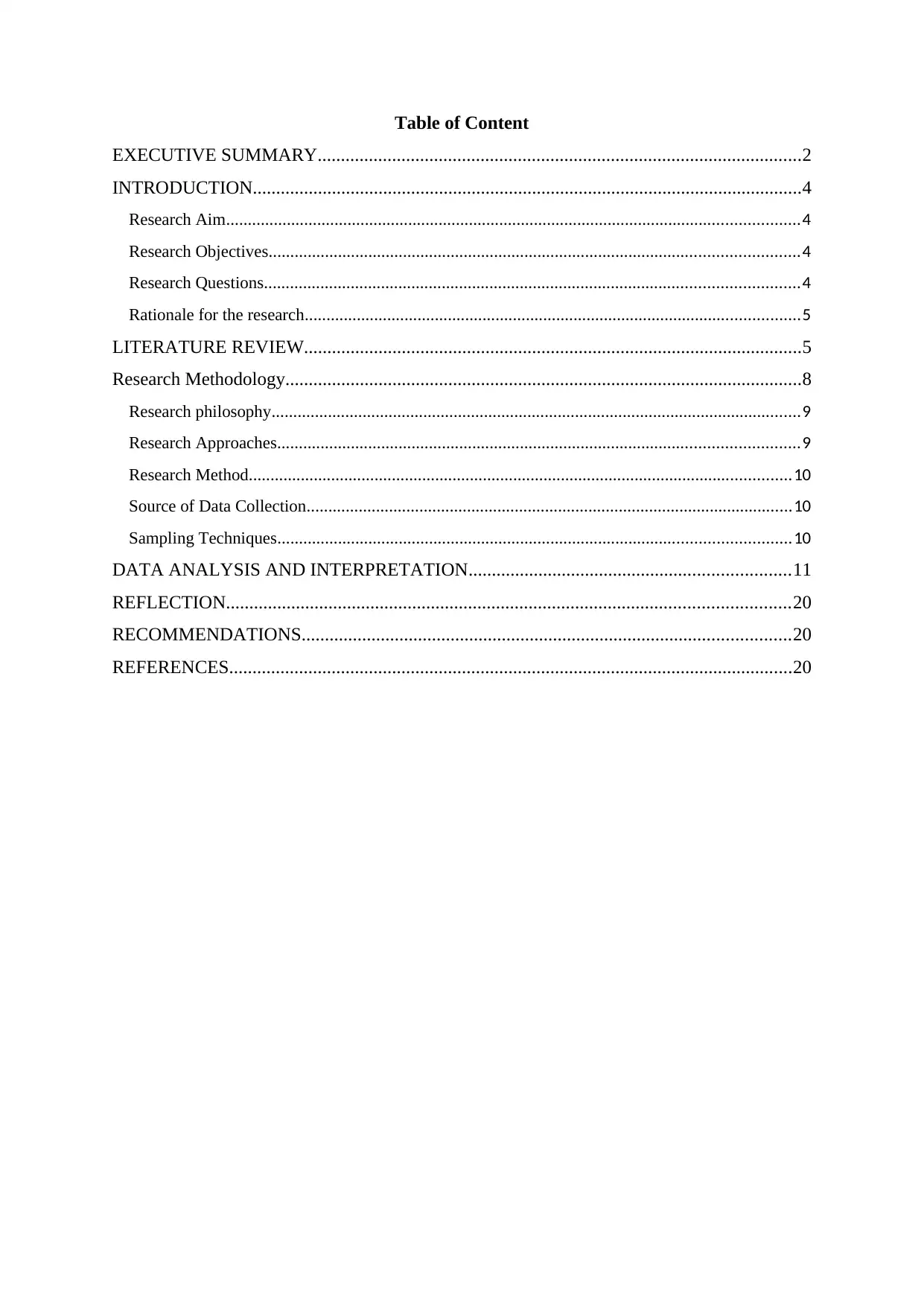
Table of Content
EXECUTIVE SUMMARY........................................................................................................2
INTRODUCTION......................................................................................................................4
Research Aim....................................................................................................................................4
Research Objectives..........................................................................................................................4
Research Questions...........................................................................................................................4
Rationale for the research..................................................................................................................5
LITERATURE REVIEW...........................................................................................................5
Research Methodology...............................................................................................................8
Research philosophy..........................................................................................................................9
Research Approaches........................................................................................................................9
Research Method.............................................................................................................................10
Source of Data Collection................................................................................................................10
Sampling Techniques......................................................................................................................10
DATA ANALYSIS AND INTERPRETATION.....................................................................11
REFLECTION.........................................................................................................................20
RECOMMENDATIONS.........................................................................................................20
REFERENCES.........................................................................................................................20
EXECUTIVE SUMMARY........................................................................................................2
INTRODUCTION......................................................................................................................4
Research Aim....................................................................................................................................4
Research Objectives..........................................................................................................................4
Research Questions...........................................................................................................................4
Rationale for the research..................................................................................................................5
LITERATURE REVIEW...........................................................................................................5
Research Methodology...............................................................................................................8
Research philosophy..........................................................................................................................9
Research Approaches........................................................................................................................9
Research Method.............................................................................................................................10
Source of Data Collection................................................................................................................10
Sampling Techniques......................................................................................................................10
DATA ANALYSIS AND INTERPRETATION.....................................................................11
REFLECTION.........................................................................................................................20
RECOMMENDATIONS.........................................................................................................20
REFERENCES.........................................................................................................................20
⊘ This is a preview!⊘
Do you want full access?
Subscribe today to unlock all pages.

Trusted by 1+ million students worldwide
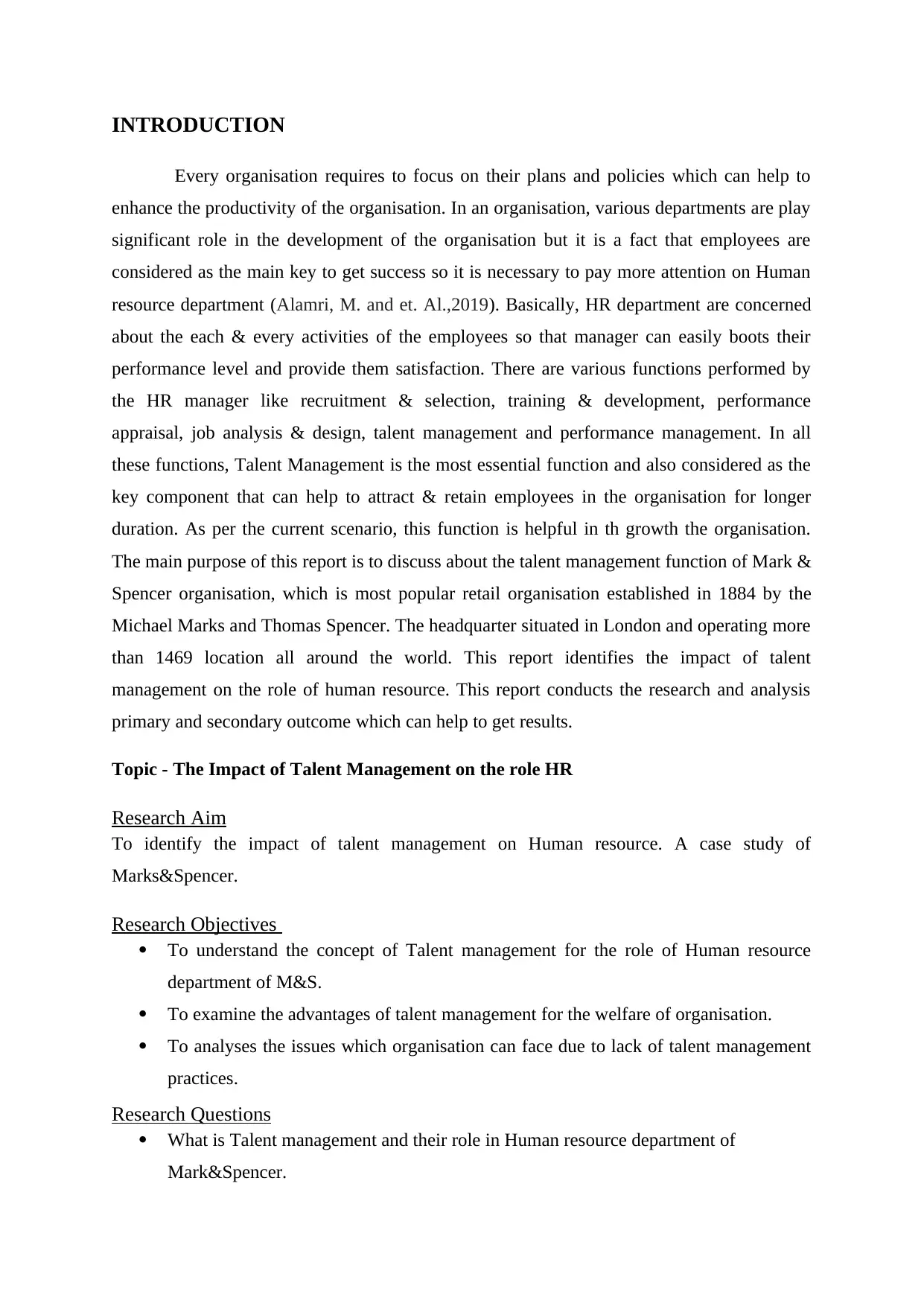
INTRODUCTION
Every organisation requires to focus on their plans and policies which can help to
enhance the productivity of the organisation. In an organisation, various departments are play
significant role in the development of the organisation but it is a fact that employees are
considered as the main key to get success so it is necessary to pay more attention on Human
resource department (Alamri, M. and et. Al.,2019). Basically, HR department are concerned
about the each & every activities of the employees so that manager can easily boots their
performance level and provide them satisfaction. There are various functions performed by
the HR manager like recruitment & selection, training & development, performance
appraisal, job analysis & design, talent management and performance management. In all
these functions, Talent Management is the most essential function and also considered as the
key component that can help to attract & retain employees in the organisation for longer
duration. As per the current scenario, this function is helpful in th growth the organisation.
The main purpose of this report is to discuss about the talent management function of Mark &
Spencer organisation, which is most popular retail organisation established in 1884 by the
Michael Marks and Thomas Spencer. The headquarter situated in London and operating more
than 1469 location all around the world. This report identifies the impact of talent
management on the role of human resource. This report conducts the research and analysis
primary and secondary outcome which can help to get results.
Topic - The Impact of Talent Management on the role HR
Research Aim
To identify the impact of talent management on Human resource. A case study of
Marks&Spencer.
Research Objectives
To understand the concept of Talent management for the role of Human resource
department of M&S.
To examine the advantages of talent management for the welfare of organisation.
To analyses the issues which organisation can face due to lack of talent management
practices.
Research Questions
What is Talent management and their role in Human resource department of
Mark&Spencer.
Every organisation requires to focus on their plans and policies which can help to
enhance the productivity of the organisation. In an organisation, various departments are play
significant role in the development of the organisation but it is a fact that employees are
considered as the main key to get success so it is necessary to pay more attention on Human
resource department (Alamri, M. and et. Al.,2019). Basically, HR department are concerned
about the each & every activities of the employees so that manager can easily boots their
performance level and provide them satisfaction. There are various functions performed by
the HR manager like recruitment & selection, training & development, performance
appraisal, job analysis & design, talent management and performance management. In all
these functions, Talent Management is the most essential function and also considered as the
key component that can help to attract & retain employees in the organisation for longer
duration. As per the current scenario, this function is helpful in th growth the organisation.
The main purpose of this report is to discuss about the talent management function of Mark &
Spencer organisation, which is most popular retail organisation established in 1884 by the
Michael Marks and Thomas Spencer. The headquarter situated in London and operating more
than 1469 location all around the world. This report identifies the impact of talent
management on the role of human resource. This report conducts the research and analysis
primary and secondary outcome which can help to get results.
Topic - The Impact of Talent Management on the role HR
Research Aim
To identify the impact of talent management on Human resource. A case study of
Marks&Spencer.
Research Objectives
To understand the concept of Talent management for the role of Human resource
department of M&S.
To examine the advantages of talent management for the welfare of organisation.
To analyses the issues which organisation can face due to lack of talent management
practices.
Research Questions
What is Talent management and their role in Human resource department of
Mark&Spencer.
Paraphrase This Document
Need a fresh take? Get an instant paraphrase of this document with our AI Paraphraser
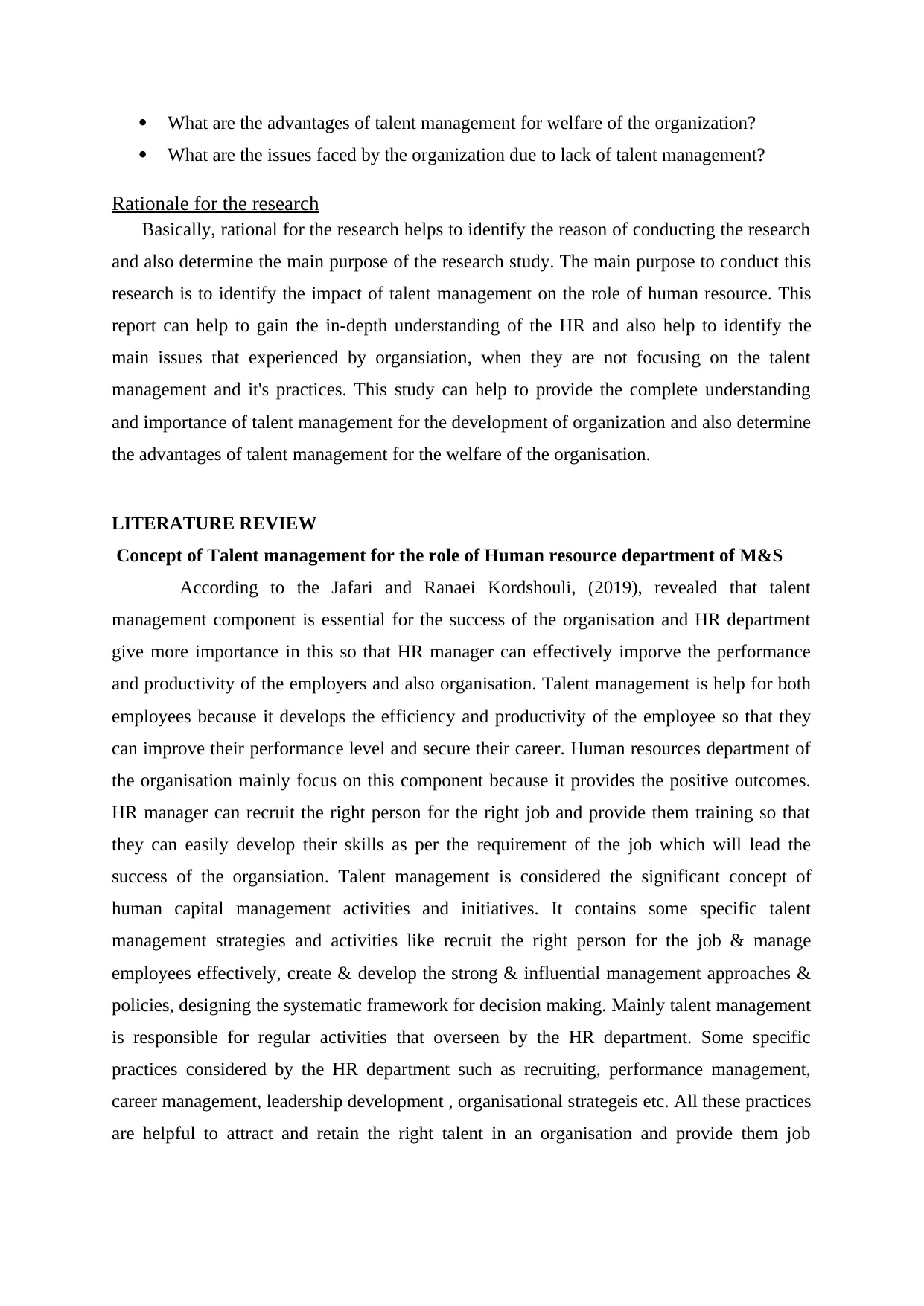
What are the advantages of talent management for welfare of the organization?
What are the issues faced by the organization due to lack of talent management?
Rationale for the research
Basically, rational for the research helps to identify the reason of conducting the research
and also determine the main purpose of the research study. The main purpose to conduct this
research is to identify the impact of talent management on the role of human resource. This
report can help to gain the in-depth understanding of the HR and also help to identify the
main issues that experienced by organsiation, when they are not focusing on the talent
management and it's practices. This study can help to provide the complete understanding
and importance of talent management for the development of organization and also determine
the advantages of talent management for the welfare of the organisation.
LITERATURE REVIEW
Concept of Talent management for the role of Human resource department of M&S
According to the Jafari and Ranaei Kordshouli, (2019), revealed that talent
management component is essential for the success of the organisation and HR department
give more importance in this so that HR manager can effectively imporve the performance
and productivity of the employers and also organisation. Talent management is help for both
employees because it develops the efficiency and productivity of the employee so that they
can improve their performance level and secure their career. Human resources department of
the organisation mainly focus on this component because it provides the positive outcomes.
HR manager can recruit the right person for the right job and provide them training so that
they can easily develop their skills as per the requirement of the job which will lead the
success of the organsiation. Talent management is considered the significant concept of
human capital management activities and initiatives. It contains some specific talent
management strategies and activities like recruit the right person for the job & manage
employees effectively, create & develop the strong & influential management approaches &
policies, designing the systematic framework for decision making. Mainly talent management
is responsible for regular activities that overseen by the HR department. Some specific
practices considered by the HR department such as recruiting, performance management,
career management, leadership development , organisational strategeis etc. All these practices
are helpful to attract and retain the right talent in an organisation and provide them job
What are the issues faced by the organization due to lack of talent management?
Rationale for the research
Basically, rational for the research helps to identify the reason of conducting the research
and also determine the main purpose of the research study. The main purpose to conduct this
research is to identify the impact of talent management on the role of human resource. This
report can help to gain the in-depth understanding of the HR and also help to identify the
main issues that experienced by organsiation, when they are not focusing on the talent
management and it's practices. This study can help to provide the complete understanding
and importance of talent management for the development of organization and also determine
the advantages of talent management for the welfare of the organisation.
LITERATURE REVIEW
Concept of Talent management for the role of Human resource department of M&S
According to the Jafari and Ranaei Kordshouli, (2019), revealed that talent
management component is essential for the success of the organisation and HR department
give more importance in this so that HR manager can effectively imporve the performance
and productivity of the employers and also organisation. Talent management is help for both
employees because it develops the efficiency and productivity of the employee so that they
can improve their performance level and secure their career. Human resources department of
the organisation mainly focus on this component because it provides the positive outcomes.
HR manager can recruit the right person for the right job and provide them training so that
they can easily develop their skills as per the requirement of the job which will lead the
success of the organsiation. Talent management is considered the significant concept of
human capital management activities and initiatives. It contains some specific talent
management strategies and activities like recruit the right person for the job & manage
employees effectively, create & develop the strong & influential management approaches &
policies, designing the systematic framework for decision making. Mainly talent management
is responsible for regular activities that overseen by the HR department. Some specific
practices considered by the HR department such as recruiting, performance management,
career management, leadership development , organisational strategeis etc. All these practices
are helpful to attract and retain the right talent in an organisation and provide them job
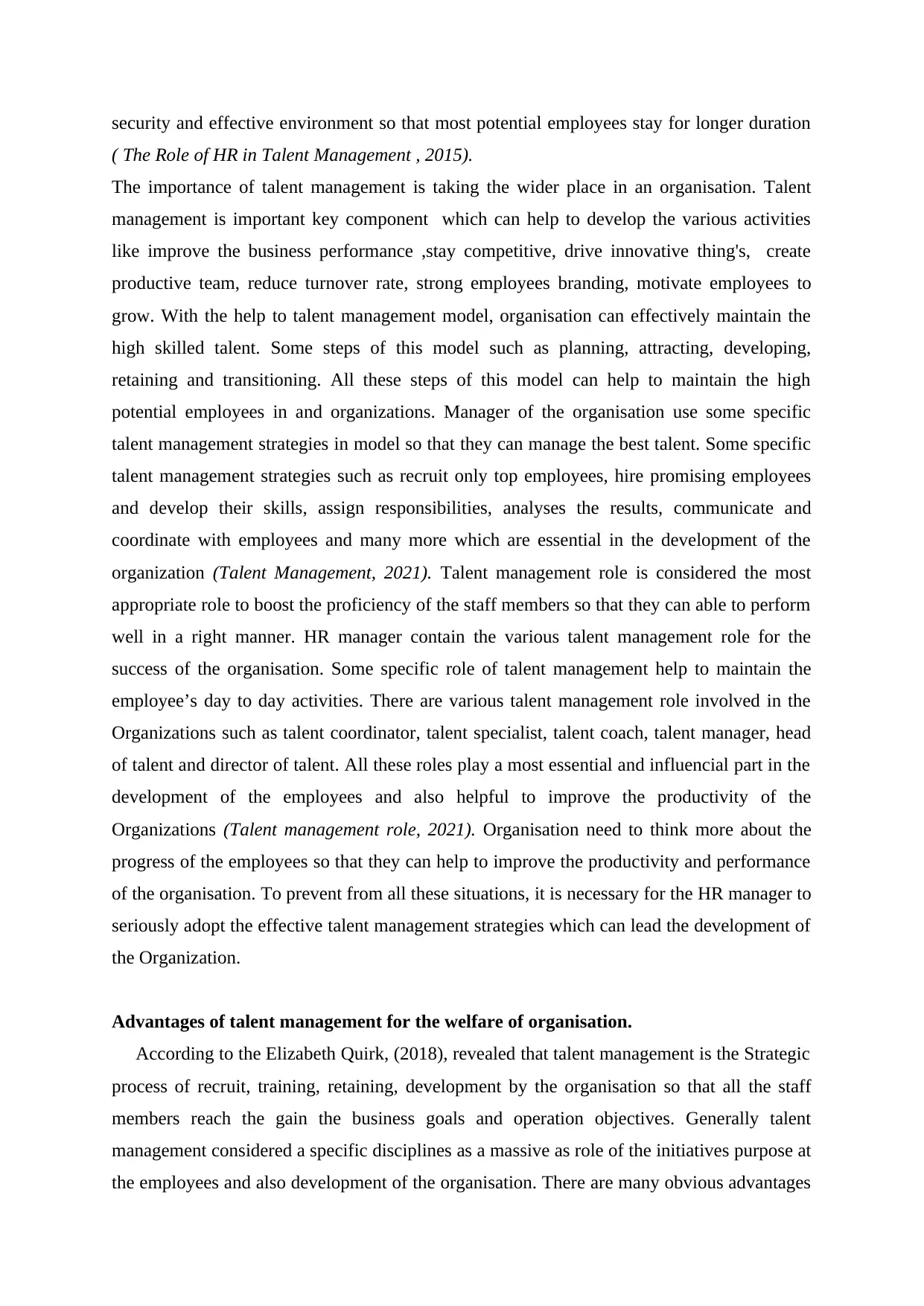
security and effective environment so that most potential employees stay for longer duration
( The Role of HR in Talent Management , 2015).
The importance of talent management is taking the wider place in an organisation. Talent
management is important key component which can help to develop the various activities
like improve the business performance ,stay competitive, drive innovative thing's, create
productive team, reduce turnover rate, strong employees branding, motivate employees to
grow. With the help to talent management model, organisation can effectively maintain the
high skilled talent. Some steps of this model such as planning, attracting, developing,
retaining and transitioning. All these steps of this model can help to maintain the high
potential employees in and organizations. Manager of the organisation use some specific
talent management strategies in model so that they can manage the best talent. Some specific
talent management strategies such as recruit only top employees, hire promising employees
and develop their skills, assign responsibilities, analyses the results, communicate and
coordinate with employees and many more which are essential in the development of the
organization (Talent Management, 2021). Talent management role is considered the most
appropriate role to boost the proficiency of the staff members so that they can able to perform
well in a right manner. HR manager contain the various talent management role for the
success of the organisation. Some specific role of talent management help to maintain the
employee’s day to day activities. There are various talent management role involved in the
Organizations such as talent coordinator, talent specialist, talent coach, talent manager, head
of talent and director of talent. All these roles play a most essential and influencial part in the
development of the employees and also helpful to improve the productivity of the
Organizations (Talent management role, 2021). Organisation need to think more about the
progress of the employees so that they can help to improve the productivity and performance
of the organisation. To prevent from all these situations, it is necessary for the HR manager to
seriously adopt the effective talent management strategies which can lead the development of
the Organization.
Advantages of talent management for the welfare of organisation.
According to the Elizabeth Quirk, (2018), revealed that talent management is the Strategic
process of recruit, training, retaining, development by the organisation so that all the staff
members reach the gain the business goals and operation objectives. Generally talent
management considered a specific disciplines as a massive as role of the initiatives purpose at
the employees and also development of the organisation. There are many obvious advantages
( The Role of HR in Talent Management , 2015).
The importance of talent management is taking the wider place in an organisation. Talent
management is important key component which can help to develop the various activities
like improve the business performance ,stay competitive, drive innovative thing's, create
productive team, reduce turnover rate, strong employees branding, motivate employees to
grow. With the help to talent management model, organisation can effectively maintain the
high skilled talent. Some steps of this model such as planning, attracting, developing,
retaining and transitioning. All these steps of this model can help to maintain the high
potential employees in and organizations. Manager of the organisation use some specific
talent management strategies in model so that they can manage the best talent. Some specific
talent management strategies such as recruit only top employees, hire promising employees
and develop their skills, assign responsibilities, analyses the results, communicate and
coordinate with employees and many more which are essential in the development of the
organization (Talent Management, 2021). Talent management role is considered the most
appropriate role to boost the proficiency of the staff members so that they can able to perform
well in a right manner. HR manager contain the various talent management role for the
success of the organisation. Some specific role of talent management help to maintain the
employee’s day to day activities. There are various talent management role involved in the
Organizations such as talent coordinator, talent specialist, talent coach, talent manager, head
of talent and director of talent. All these roles play a most essential and influencial part in the
development of the employees and also helpful to improve the productivity of the
Organizations (Talent management role, 2021). Organisation need to think more about the
progress of the employees so that they can help to improve the productivity and performance
of the organisation. To prevent from all these situations, it is necessary for the HR manager to
seriously adopt the effective talent management strategies which can lead the development of
the Organization.
Advantages of talent management for the welfare of organisation.
According to the Elizabeth Quirk, (2018), revealed that talent management is the Strategic
process of recruit, training, retaining, development by the organisation so that all the staff
members reach the gain the business goals and operation objectives. Generally talent
management considered a specific disciplines as a massive as role of the initiatives purpose at
the employees and also development of the organisation. There are many obvious advantages
⊘ This is a preview!⊘
Do you want full access?
Subscribe today to unlock all pages.

Trusted by 1+ million students worldwide
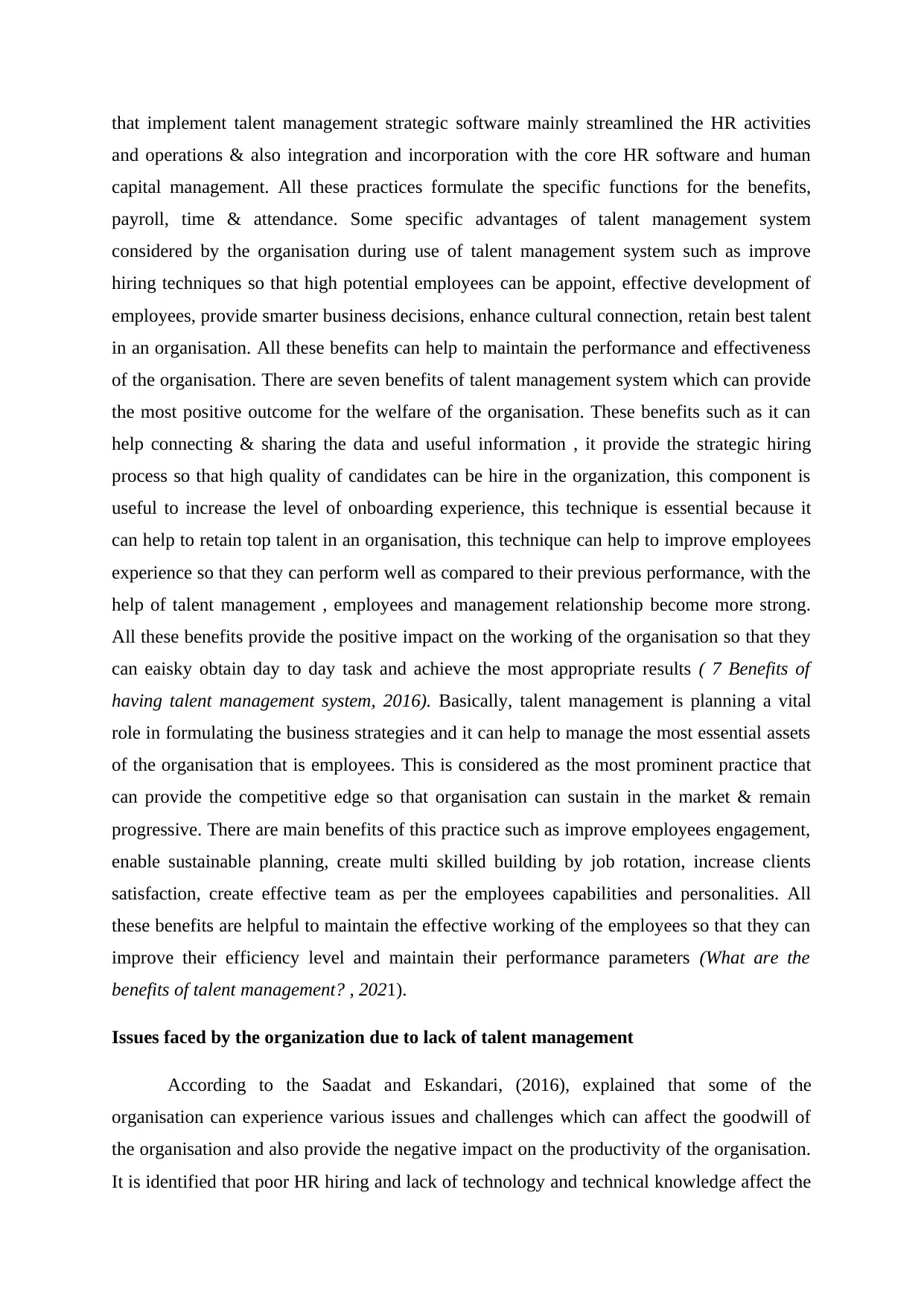
that implement talent management strategic software mainly streamlined the HR activities
and operations & also integration and incorporation with the core HR software and human
capital management. All these practices formulate the specific functions for the benefits,
payroll, time & attendance. Some specific advantages of talent management system
considered by the organisation during use of talent management system such as improve
hiring techniques so that high potential employees can be appoint, effective development of
employees, provide smarter business decisions, enhance cultural connection, retain best talent
in an organisation. All these benefits can help to maintain the performance and effectiveness
of the organisation. There are seven benefits of talent management system which can provide
the most positive outcome for the welfare of the organisation. These benefits such as it can
help connecting & sharing the data and useful information , it provide the strategic hiring
process so that high quality of candidates can be hire in the organization, this component is
useful to increase the level of onboarding experience, this technique is essential because it
can help to retain top talent in an organisation, this technique can help to improve employees
experience so that they can perform well as compared to their previous performance, with the
help of talent management , employees and management relationship become more strong.
All these benefits provide the positive impact on the working of the organisation so that they
can eaisky obtain day to day task and achieve the most appropriate results ( 7 Benefits of
having talent management system, 2016). Basically, talent management is planning a vital
role in formulating the business strategies and it can help to manage the most essential assets
of the organisation that is employees. This is considered as the most prominent practice that
can provide the competitive edge so that organisation can sustain in the market & remain
progressive. There are main benefits of this practice such as improve employees engagement,
enable sustainable planning, create multi skilled building by job rotation, increase clients
satisfaction, create effective team as per the employees capabilities and personalities. All
these benefits are helpful to maintain the effective working of the employees so that they can
improve their efficiency level and maintain their performance parameters (What are the
benefits of talent management? , 2021).
Issues faced by the organization due to lack of talent management
According to the Saadat and Eskandari, (2016), explained that some of the
organisation can experience various issues and challenges which can affect the goodwill of
the organisation and also provide the negative impact on the productivity of the organisation.
It is identified that poor HR hiring and lack of technology and technical knowledge affect the
and operations & also integration and incorporation with the core HR software and human
capital management. All these practices formulate the specific functions for the benefits,
payroll, time & attendance. Some specific advantages of talent management system
considered by the organisation during use of talent management system such as improve
hiring techniques so that high potential employees can be appoint, effective development of
employees, provide smarter business decisions, enhance cultural connection, retain best talent
in an organisation. All these benefits can help to maintain the performance and effectiveness
of the organisation. There are seven benefits of talent management system which can provide
the most positive outcome for the welfare of the organisation. These benefits such as it can
help connecting & sharing the data and useful information , it provide the strategic hiring
process so that high quality of candidates can be hire in the organization, this component is
useful to increase the level of onboarding experience, this technique is essential because it
can help to retain top talent in an organisation, this technique can help to improve employees
experience so that they can perform well as compared to their previous performance, with the
help of talent management , employees and management relationship become more strong.
All these benefits provide the positive impact on the working of the organisation so that they
can eaisky obtain day to day task and achieve the most appropriate results ( 7 Benefits of
having talent management system, 2016). Basically, talent management is planning a vital
role in formulating the business strategies and it can help to manage the most essential assets
of the organisation that is employees. This is considered as the most prominent practice that
can provide the competitive edge so that organisation can sustain in the market & remain
progressive. There are main benefits of this practice such as improve employees engagement,
enable sustainable planning, create multi skilled building by job rotation, increase clients
satisfaction, create effective team as per the employees capabilities and personalities. All
these benefits are helpful to maintain the effective working of the employees so that they can
improve their efficiency level and maintain their performance parameters (What are the
benefits of talent management? , 2021).
Issues faced by the organization due to lack of talent management
According to the Saadat and Eskandari, (2016), explained that some of the
organisation can experience various issues and challenges which can affect the goodwill of
the organisation and also provide the negative impact on the productivity of the organisation.
It is identified that poor HR hiring and lack of technology and technical knowledge affect the
Paraphrase This Document
Need a fresh take? Get an instant paraphrase of this document with our AI Paraphraser
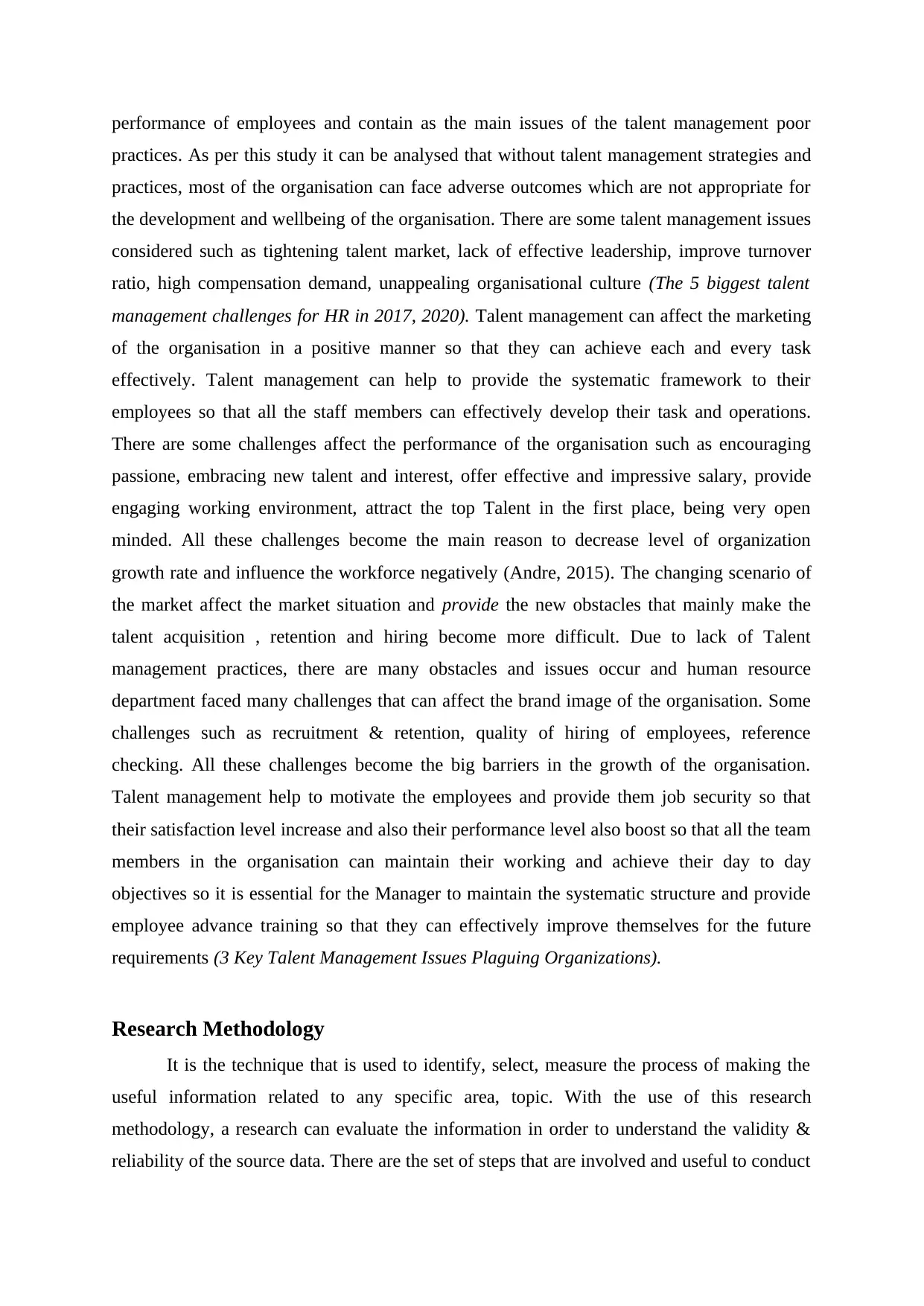
performance of employees and contain as the main issues of the talent management poor
practices. As per this study it can be analysed that without talent management strategies and
practices, most of the organisation can face adverse outcomes which are not appropriate for
the development and wellbeing of the organisation. There are some talent management issues
considered such as tightening talent market, lack of effective leadership, improve turnover
ratio, high compensation demand, unappealing organisational culture (The 5 biggest talent
management challenges for HR in 2017, 2020). Talent management can affect the marketing
of the organisation in a positive manner so that they can achieve each and every task
effectively. Talent management can help to provide the systematic framework to their
employees so that all the staff members can effectively develop their task and operations.
There are some challenges affect the performance of the organisation such as encouraging
passione, embracing new talent and interest, offer effective and impressive salary, provide
engaging working environment, attract the top Talent in the first place, being very open
minded. All these challenges become the main reason to decrease level of organization
growth rate and influence the workforce negatively (Andre, 2015). The changing scenario of
the market affect the market situation and provide the new obstacles that mainly make the
talent acquisition , retention and hiring become more difficult. Due to lack of Talent
management practices, there are many obstacles and issues occur and human resource
department faced many challenges that can affect the brand image of the organisation. Some
challenges such as recruitment & retention, quality of hiring of employees, reference
checking. All these challenges become the big barriers in the growth of the organisation.
Talent management help to motivate the employees and provide them job security so that
their satisfaction level increase and also their performance level also boost so that all the team
members in the organisation can maintain their working and achieve their day to day
objectives so it is essential for the Manager to maintain the systematic structure and provide
employee advance training so that they can effectively improve themselves for the future
requirements (3 Key Talent Management Issues Plaguing Organizations).
Research Methodology
It is the technique that is used to identify, select, measure the process of making the
useful information related to any specific area, topic. With the use of this research
methodology, a research can evaluate the information in order to understand the validity &
reliability of the source data. There are the set of steps that are involved and useful to conduct
practices. As per this study it can be analysed that without talent management strategies and
practices, most of the organisation can face adverse outcomes which are not appropriate for
the development and wellbeing of the organisation. There are some talent management issues
considered such as tightening talent market, lack of effective leadership, improve turnover
ratio, high compensation demand, unappealing organisational culture (The 5 biggest talent
management challenges for HR in 2017, 2020). Talent management can affect the marketing
of the organisation in a positive manner so that they can achieve each and every task
effectively. Talent management can help to provide the systematic framework to their
employees so that all the staff members can effectively develop their task and operations.
There are some challenges affect the performance of the organisation such as encouraging
passione, embracing new talent and interest, offer effective and impressive salary, provide
engaging working environment, attract the top Talent in the first place, being very open
minded. All these challenges become the main reason to decrease level of organization
growth rate and influence the workforce negatively (Andre, 2015). The changing scenario of
the market affect the market situation and provide the new obstacles that mainly make the
talent acquisition , retention and hiring become more difficult. Due to lack of Talent
management practices, there are many obstacles and issues occur and human resource
department faced many challenges that can affect the brand image of the organisation. Some
challenges such as recruitment & retention, quality of hiring of employees, reference
checking. All these challenges become the big barriers in the growth of the organisation.
Talent management help to motivate the employees and provide them job security so that
their satisfaction level increase and also their performance level also boost so that all the team
members in the organisation can maintain their working and achieve their day to day
objectives so it is essential for the Manager to maintain the systematic structure and provide
employee advance training so that they can effectively improve themselves for the future
requirements (3 Key Talent Management Issues Plaguing Organizations).
Research Methodology
It is the technique that is used to identify, select, measure the process of making the
useful information related to any specific area, topic. With the use of this research
methodology, a research can evaluate the information in order to understand the validity &
reliability of the source data. There are the set of steps that are involved and useful to conduct
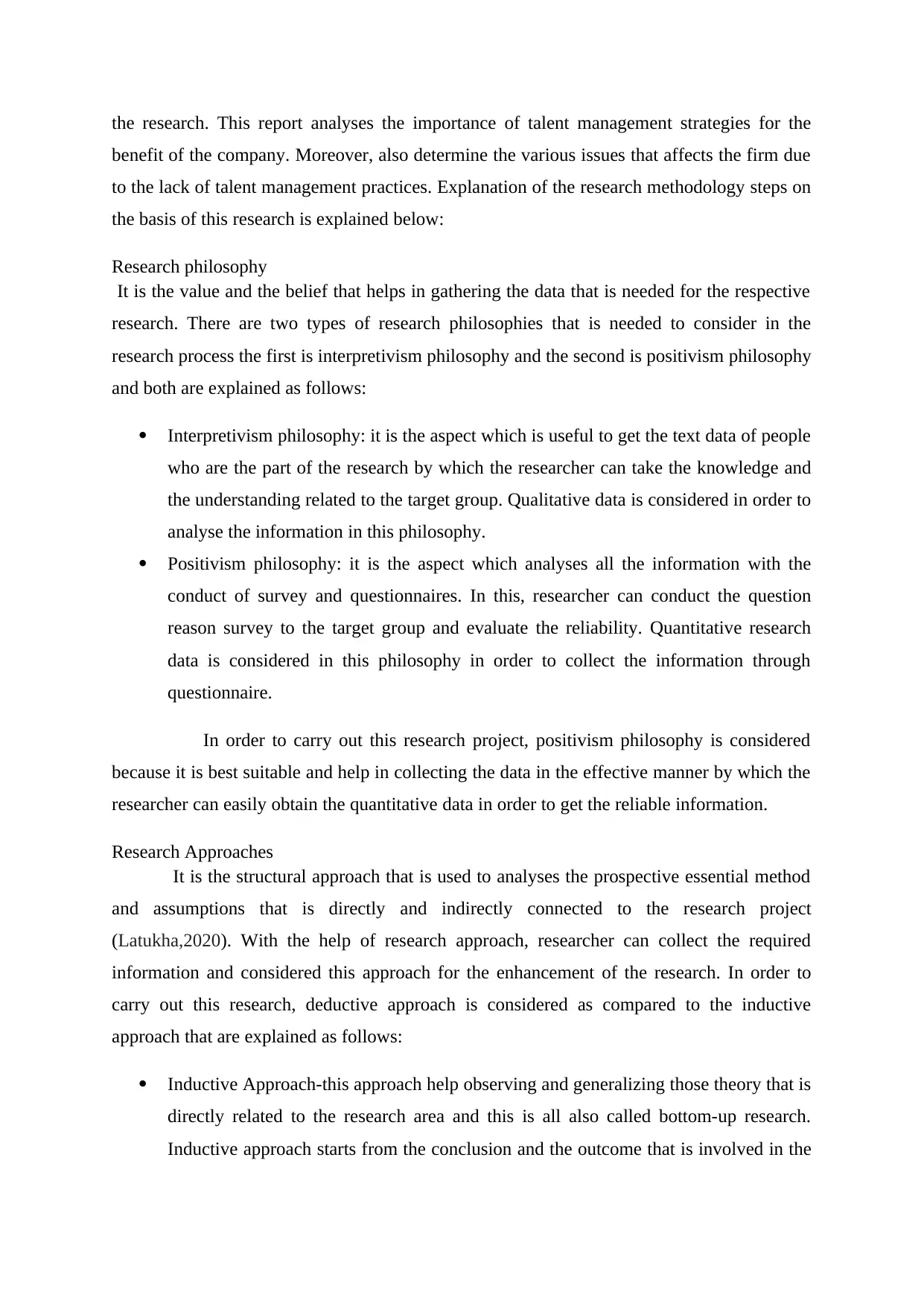
the research. This report analyses the importance of talent management strategies for the
benefit of the company. Moreover, also determine the various issues that affects the firm due
to the lack of talent management practices. Explanation of the research methodology steps on
the basis of this research is explained below:
Research philosophy
It is the value and the belief that helps in gathering the data that is needed for the respective
research. There are two types of research philosophies that is needed to consider in the
research process the first is interpretivism philosophy and the second is positivism philosophy
and both are explained as follows:
Interpretivism philosophy: it is the aspect which is useful to get the text data of people
who are the part of the research by which the researcher can take the knowledge and
the understanding related to the target group. Qualitative data is considered in order to
analyse the information in this philosophy.
Positivism philosophy: it is the aspect which analyses all the information with the
conduct of survey and questionnaires. In this, researcher can conduct the question
reason survey to the target group and evaluate the reliability. Quantitative research
data is considered in this philosophy in order to collect the information through
questionnaire.
In order to carry out this research project, positivism philosophy is considered
because it is best suitable and help in collecting the data in the effective manner by which the
researcher can easily obtain the quantitative data in order to get the reliable information.
Research Approaches
It is the structural approach that is used to analyses the prospective essential method
and assumptions that is directly and indirectly connected to the research project
(Latukha,2020). With the help of research approach, researcher can collect the required
information and considered this approach for the enhancement of the research. In order to
carry out this research, deductive approach is considered as compared to the inductive
approach that are explained as follows:
Inductive Approach-this approach help observing and generalizing those theory that is
directly related to the research area and this is all also called bottom-up research.
Inductive approach starts from the conclusion and the outcome that is involved in the
benefit of the company. Moreover, also determine the various issues that affects the firm due
to the lack of talent management practices. Explanation of the research methodology steps on
the basis of this research is explained below:
Research philosophy
It is the value and the belief that helps in gathering the data that is needed for the respective
research. There are two types of research philosophies that is needed to consider in the
research process the first is interpretivism philosophy and the second is positivism philosophy
and both are explained as follows:
Interpretivism philosophy: it is the aspect which is useful to get the text data of people
who are the part of the research by which the researcher can take the knowledge and
the understanding related to the target group. Qualitative data is considered in order to
analyse the information in this philosophy.
Positivism philosophy: it is the aspect which analyses all the information with the
conduct of survey and questionnaires. In this, researcher can conduct the question
reason survey to the target group and evaluate the reliability. Quantitative research
data is considered in this philosophy in order to collect the information through
questionnaire.
In order to carry out this research project, positivism philosophy is considered
because it is best suitable and help in collecting the data in the effective manner by which the
researcher can easily obtain the quantitative data in order to get the reliable information.
Research Approaches
It is the structural approach that is used to analyses the prospective essential method
and assumptions that is directly and indirectly connected to the research project
(Latukha,2020). With the help of research approach, researcher can collect the required
information and considered this approach for the enhancement of the research. In order to
carry out this research, deductive approach is considered as compared to the inductive
approach that are explained as follows:
Inductive Approach-this approach help observing and generalizing those theory that is
directly related to the research area and this is all also called bottom-up research.
Inductive approach starts from the conclusion and the outcome that is involved in the
⊘ This is a preview!⊘
Do you want full access?
Subscribe today to unlock all pages.

Trusted by 1+ million students worldwide
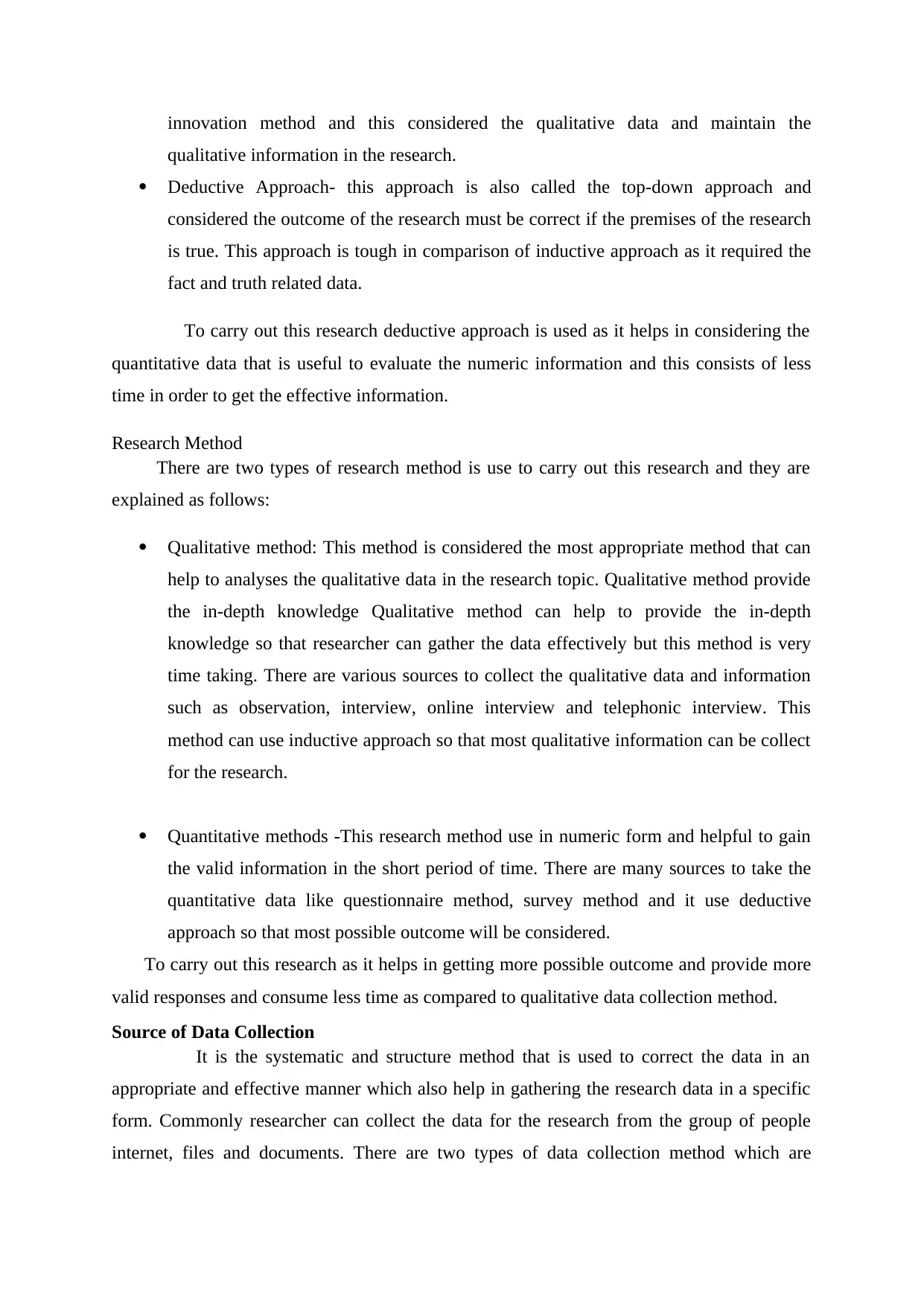
innovation method and this considered the qualitative data and maintain the
qualitative information in the research.
Deductive Approach- this approach is also called the top-down approach and
considered the outcome of the research must be correct if the premises of the research
is true. This approach is tough in comparison of inductive approach as it required the
fact and truth related data.
To carry out this research deductive approach is used as it helps in considering the
quantitative data that is useful to evaluate the numeric information and this consists of less
time in order to get the effective information.
Research Method
There are two types of research method is use to carry out this research and they are
explained as follows:
Qualitative method: This method is considered the most appropriate method that can
help to analyses the qualitative data in the research topic. Qualitative method provide
the in-depth knowledge Qualitative method can help to provide the in-depth
knowledge so that researcher can gather the data effectively but this method is very
time taking. There are various sources to collect the qualitative data and information
such as observation, interview, online interview and telephonic interview. This
method can use inductive approach so that most qualitative information can be collect
for the research.
Quantitative methods -This research method use in numeric form and helpful to gain
the valid information in the short period of time. There are many sources to take the
quantitative data like questionnaire method, survey method and it use deductive
approach so that most possible outcome will be considered.
To carry out this research as it helps in getting more possible outcome and provide more
valid responses and consume less time as compared to qualitative data collection method.
Source of Data Collection
It is the systematic and structure method that is used to correct the data in an
appropriate and effective manner which also help in gathering the research data in a specific
form. Commonly researcher can collect the data for the research from the group of people
internet, files and documents. There are two types of data collection method which are
qualitative information in the research.
Deductive Approach- this approach is also called the top-down approach and
considered the outcome of the research must be correct if the premises of the research
is true. This approach is tough in comparison of inductive approach as it required the
fact and truth related data.
To carry out this research deductive approach is used as it helps in considering the
quantitative data that is useful to evaluate the numeric information and this consists of less
time in order to get the effective information.
Research Method
There are two types of research method is use to carry out this research and they are
explained as follows:
Qualitative method: This method is considered the most appropriate method that can
help to analyses the qualitative data in the research topic. Qualitative method provide
the in-depth knowledge Qualitative method can help to provide the in-depth
knowledge so that researcher can gather the data effectively but this method is very
time taking. There are various sources to collect the qualitative data and information
such as observation, interview, online interview and telephonic interview. This
method can use inductive approach so that most qualitative information can be collect
for the research.
Quantitative methods -This research method use in numeric form and helpful to gain
the valid information in the short period of time. There are many sources to take the
quantitative data like questionnaire method, survey method and it use deductive
approach so that most possible outcome will be considered.
To carry out this research as it helps in getting more possible outcome and provide more
valid responses and consume less time as compared to qualitative data collection method.
Source of Data Collection
It is the systematic and structure method that is used to correct the data in an
appropriate and effective manner which also help in gathering the research data in a specific
form. Commonly researcher can collect the data for the research from the group of people
internet, files and documents. There are two types of data collection method which are
Paraphrase This Document
Need a fresh take? Get an instant paraphrase of this document with our AI Paraphraser
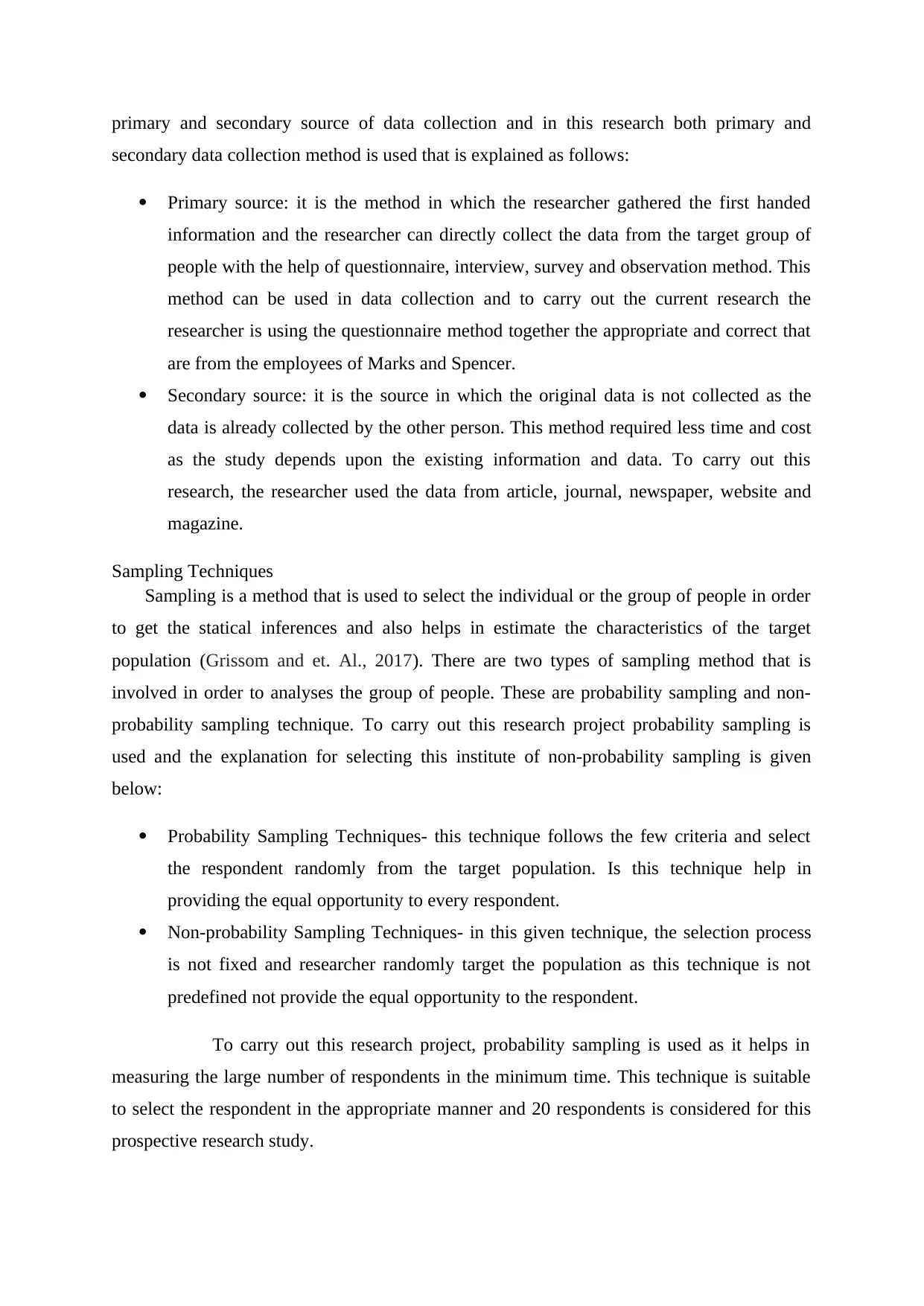
primary and secondary source of data collection and in this research both primary and
secondary data collection method is used that is explained as follows:
Primary source: it is the method in which the researcher gathered the first handed
information and the researcher can directly collect the data from the target group of
people with the help of questionnaire, interview, survey and observation method. This
method can be used in data collection and to carry out the current research the
researcher is using the questionnaire method together the appropriate and correct that
are from the employees of Marks and Spencer.
Secondary source: it is the source in which the original data is not collected as the
data is already collected by the other person. This method required less time and cost
as the study depends upon the existing information and data. To carry out this
research, the researcher used the data from article, journal, newspaper, website and
magazine.
Sampling Techniques
Sampling is a method that is used to select the individual or the group of people in order
to get the statical inferences and also helps in estimate the characteristics of the target
population (Grissom and et. Al., 2017). There are two types of sampling method that is
involved in order to analyses the group of people. These are probability sampling and non-
probability sampling technique. To carry out this research project probability sampling is
used and the explanation for selecting this institute of non-probability sampling is given
below:
Probability Sampling Techniques- this technique follows the few criteria and select
the respondent randomly from the target population. Is this technique help in
providing the equal opportunity to every respondent.
Non-probability Sampling Techniques- in this given technique, the selection process
is not fixed and researcher randomly target the population as this technique is not
predefined not provide the equal opportunity to the respondent.
To carry out this research project, probability sampling is used as it helps in
measuring the large number of respondents in the minimum time. This technique is suitable
to select the respondent in the appropriate manner and 20 respondents is considered for this
prospective research study.
secondary data collection method is used that is explained as follows:
Primary source: it is the method in which the researcher gathered the first handed
information and the researcher can directly collect the data from the target group of
people with the help of questionnaire, interview, survey and observation method. This
method can be used in data collection and to carry out the current research the
researcher is using the questionnaire method together the appropriate and correct that
are from the employees of Marks and Spencer.
Secondary source: it is the source in which the original data is not collected as the
data is already collected by the other person. This method required less time and cost
as the study depends upon the existing information and data. To carry out this
research, the researcher used the data from article, journal, newspaper, website and
magazine.
Sampling Techniques
Sampling is a method that is used to select the individual or the group of people in order
to get the statical inferences and also helps in estimate the characteristics of the target
population (Grissom and et. Al., 2017). There are two types of sampling method that is
involved in order to analyses the group of people. These are probability sampling and non-
probability sampling technique. To carry out this research project probability sampling is
used and the explanation for selecting this institute of non-probability sampling is given
below:
Probability Sampling Techniques- this technique follows the few criteria and select
the respondent randomly from the target population. Is this technique help in
providing the equal opportunity to every respondent.
Non-probability Sampling Techniques- in this given technique, the selection process
is not fixed and researcher randomly target the population as this technique is not
predefined not provide the equal opportunity to the respondent.
To carry out this research project, probability sampling is used as it helps in
measuring the large number of respondents in the minimum time. This technique is suitable
to select the respondent in the appropriate manner and 20 respondents is considered for this
prospective research study.
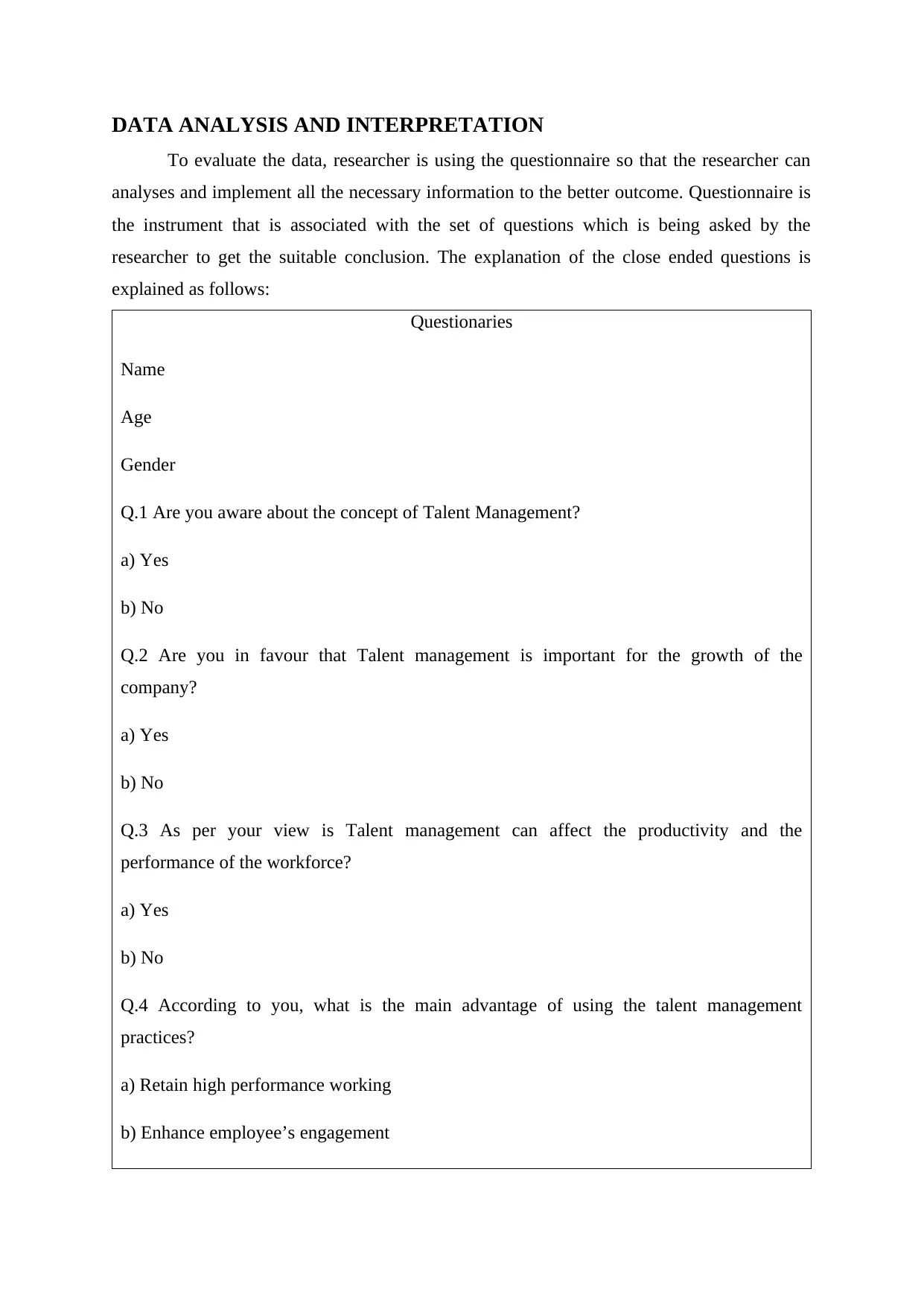
DATA ANALYSIS AND INTERPRETATION
To evaluate the data, researcher is using the questionnaire so that the researcher can
analyses and implement all the necessary information to the better outcome. Questionnaire is
the instrument that is associated with the set of questions which is being asked by the
researcher to get the suitable conclusion. The explanation of the close ended questions is
explained as follows:
Questionaries
Name
Age
Gender
Q.1 Are you aware about the concept of Talent Management?
a) Yes
b) No
Q.2 Are you in favour that Talent management is important for the growth of the
company?
a) Yes
b) No
Q.3 As per your view is Talent management can affect the productivity and the
performance of the workforce?
a) Yes
b) No
Q.4 According to you, what is the main advantage of using the talent management
practices?
a) Retain high performance working
b) Enhance employee’s engagement
To evaluate the data, researcher is using the questionnaire so that the researcher can
analyses and implement all the necessary information to the better outcome. Questionnaire is
the instrument that is associated with the set of questions which is being asked by the
researcher to get the suitable conclusion. The explanation of the close ended questions is
explained as follows:
Questionaries
Name
Age
Gender
Q.1 Are you aware about the concept of Talent Management?
a) Yes
b) No
Q.2 Are you in favour that Talent management is important for the growth of the
company?
a) Yes
b) No
Q.3 As per your view is Talent management can affect the productivity and the
performance of the workforce?
a) Yes
b) No
Q.4 According to you, what is the main advantage of using the talent management
practices?
a) Retain high performance working
b) Enhance employee’s engagement
⊘ This is a preview!⊘
Do you want full access?
Subscribe today to unlock all pages.

Trusted by 1+ million students worldwide
1 out of 30
Related Documents
Your All-in-One AI-Powered Toolkit for Academic Success.
+13062052269
info@desklib.com
Available 24*7 on WhatsApp / Email
![[object Object]](/_next/static/media/star-bottom.7253800d.svg)
Unlock your academic potential
Copyright © 2020–2025 A2Z Services. All Rights Reserved. Developed and managed by ZUCOL.





